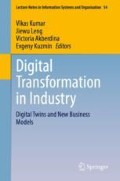Abstract
Today, the issue of digitalization can be called the most relevant. Reengineering of business processes and progress in the field of information technology correlate with the relevance of creating innovations in the system between equipment and a human. The focus of attention is payed on the concept of a data transmission network—Internet of Things, technologically equipped physical objects for interacting with each other or with the external environment. One of the most promising new information technologies is the concept of digital twins. With the simulation of production processes using the digital twin concept, it becomes possible to monitor and identify potential failures even before they occur. The active formation of this system by extensive software and hardware complexes and the integration of their solutions are in demand and relevant tools for digitalization of the country's economy and, in particular, the aviation sector. In this article, the authors analyzed various indicators of the state programs of the Russia in the field of digitalization of the aviation industry, mainly representing the results of the involvement of integrated information systems in the activities of enterprises, as well as the impact of digital twins on the efficiency of technological processes.
Access this chapter
Tax calculation will be finalised at checkout
Purchases are for personal use only
References
Shen, X., & Chen, Q. (2020). Engineering analysis is more than software. Scientific and Technical Journal from the Company, 3, 8–11.
Gusev, N. M., Kleptsov, V. I., & Lyaskin, A. S. (2016). Scientific and Technical Journal from the Company, 3, 12–15.
Santos, L. J., Oliveira, A. V. M., & Aldrighi, D. M. (2021). Testing the differentiated impact of the COVID-19 pandemic on air travel demand considering social inclusion. Journal of Air Transport Management, 94, 313. https://doi.org/10.1016/j.jairtraman.2021.102082
Yin, Z. H., & Wang, L. (2020). Application and development prospect of digital twin technology in aerospace application and development prospect of digital twin technology in aerospace. IFAC PapersOnLine, 5, 732–737. https://doi.org/10.1016/j.ifacol.2021.04.165
Erdil, A., & Erbiyik, H. (2019). The importance of benchmarking for the management of the firm: Evaluating the relation between total quality management and benchmarking. Procedia Computer Science, 158, 705–714. https://doi.org/10.1016/j.procs.2019.09.106
Khitrykh, D. P. (2020). Industry 4.0: From “smart” factories to production ecosystems. Scientific and Technical Journal from the Company, 3, 4–8.
Aladyev, A. A. (2020). Digitalization of airport infrastructure facilities and airline activities as a unified system of functioning of the civil aviation industry. Modern Science and Young Scientists, (n.d.), 101–105.
Zakharenkova, A. A. (2020). The impact of digitalization on the aviation sector. Digital Economy and Finance, (n.d.), 216–219.
Afanasyeva, O. A., & Vdovin, V. A. (2021). Methodological provisions on the integration of high-tech industrial enterprises into the digital space (on the example of aircraft industry enterprises). Innovations and Investments, 5, 243–246.
Elin, V. M. (2020). Digital twin technology. The concept and features of the approach to the organizational and legal provision of complex security. Bulletin of the South Ural State University. Series: Law, 20(3), 68–75.
Magee, J. (2020). Leaders of the industrial Internet of Things. Scientific and Technical Journal of the Company, 4, 13–17.
Digital doubles in the high-tech industry. Expert-analytical report. (2019, December 12). Retrieved October 9, 2021 from http://assets.fea.ru/uploads/fea/news/2019/12_december/28/cifrovoy_dvoinik.pdf
Leng, J., Li, X., Liu, Qi., Shen, W., Wang, D., & Chen, X. (2021). Digital twins-based smart manufacturing system design in Industry 4.0: A review. Journal of Manufacturing Systems, 60, 119–137. https://doi.org/10.1016/j.jmsy.2021.05.011
Potgieter, M. S. (2021). Modeling and optimization of complex systems and processes. Scientific and Technical Journal of the Company, 5, 21–24.
Shpak, P.S., Sycheva, E.G., & Merinskaya, E.E. (2020). The concept of digital twins as a modern trend of the digital economy. Bulletin of Omsk University. Series: Economics, 18(1), 57–68. https://doi.org/10.24147/1812-3988.2020.18(1).57-68
Resolution of the Government of the Russian Federation of 15.04.2014 N 313 (ed. of 30.11.2019) “On approval of the state program of the Russian Federation “Information Society”. (2019, November 30). Retrieved October 9, 2021 from http://www.consultant.ru/document/cons_doc_LAW_162184
Zakvaskin, A., & Komarova, E. (2020). “A new development paradigm”: How digital twins will change the aviation industry in Russia. (2020, March 30). Retrieved October 11, 2021 from https://dfnc.ru/c106-technika/novaya-paradigma-razvitiya-kak-tsifrovye-dvojniki-izmenyat-aviatsionnuyu-otrasl-rossii
Hindsbo, M. (2019). Modeling in the era of digital transformation. Scientific and Technical Journal from the Company, 5, 1–4.
Schmidt, M.-T. (2020). Application of digital dual technologies in industry. Scientific and Technical Journal of the Company, 5, 5–7.
GOST R 57700.37-2021 GOST R 57700.37-2021 Computer models and modeling. Digital doubles of products. General provisions.
Road map for the development of ‘end-to-end’ digital technologies “New production technologies” is synchronized with the Passport of the Federal project “Digital technology” program “Digital economy” until December 31, 2021. (2019, October 3). Retrieved October 9, 2021 from https://digital.gov.ru/uploaded/files/07102019npt.pdf
Indicators of innovation activity. Statistical collection. Higher School of Economics. (2019). Retrieved October 9, 2021 from http://ii_2019.pdf (hse.ru)
Volovikov, V., Krylov, A., & Makovelsky, O. (2019). Creation of a digital twin of a technical object based on system modeling. Scientific and Technical Journal from the Company, 6, 32–35.
Author information
Authors and Affiliations
Corresponding author
Editor information
Editors and Affiliations
Rights and permissions
Copyright information
© 2022 The Author(s), under exclusive license to Springer Nature Switzerland AG
About this paper
Cite this paper
Sycheva, E., Shpak, P. (2022). Practical Application of the Concept of Digital Twins in the Aviation Sector. In: Kumar, V., Leng, J., Akberdina, V., Kuzmin, E. (eds) Digital Transformation in Industry . Lecture Notes in Information Systems and Organisation, vol 54. Springer, Cham. https://doi.org/10.1007/978-3-030-94617-3_3
Download citation
DOI: https://doi.org/10.1007/978-3-030-94617-3_3
Published:
Publisher Name: Springer, Cham
Print ISBN: 978-3-030-94616-6
Online ISBN: 978-3-030-94617-3
eBook Packages: Business and ManagementBusiness and Management (R0)

